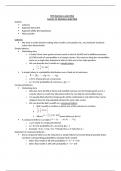MT6 Decisions under Risk
Lecture 15: Decisions under Risk
Outline:
Lotteries
Expected Value (EV)
Expected Utility (EU) hypothesis
Allais paradox
Lotteries
We want to study decision making when wealth, consumption etc. are stochastic (random)
rather than deterministic
Simple lotteries
Motivating story
o A trader (Ann) owns goods at home worth a total of $4,000 and in addition possesses
$12,000 worth of commodities in a foreign country. She wants to bring her commodities
home on a single ship. Experience tells her that one in four ships perishes.
o We can describe Ann’s wealth as a simple lottery:
A simple lottery is a probability distribution over a fixed set of outcomes:
o
o xi ∈ X. X being the set of outcomes
o pi ≥ 0 is the probability of outcome xi, ∑pi = 1
Compound lotteries
Motivating story
o Bob also owns $4,000 at home and $12,000 overseas, but his foreign goods are in a
country where a revolt may take place before he can ship his commodities home.
o It is equally likely that his foreign goods will be confiscated or not before they can be
shipped. Once his ship sails Bob will face the same risks as Ann.
o We can describe Bob's wealth as a compound lottery:
Bob’s wealth is a lottery in which one of the outcomes is a lottery
Where (same lottery as Ann's)
A compound lottery is an object
o Li are simple or compound lotteries
o pi ≥ 0 is the probability of Li occurring, ∑pi = 1
o Example: “0.5L1 + 0.5L2” for “if Heads then L1 if Tails then L2”
Reduction of compound lotteries
Every compound lottery can be reduced to a simple lottery by enumerating all possible prizes
and their corresponding probabilities. Example: Bob's wealth
o Bob’s final wealth is 4K with probability ½ + ½ * ¼ = 5/8
o Bob’s final wealth is 16K with probability ½ * ¾ = 3/8
, o
Assumption in decision making under risk: decision makers consider compound lotteries in their
reduced form (I.e. they are rational)
Plotting lotteries
Either fix the pi’s and plot the xi’s or fix the xi’s and plot the pi’s
o Lotteries are conveniently plotted either in outcome-space for given probabilities, or in
probability-space for fixed outcomes
Binary outcomes, fixed probabilities
o Consider a binary outcome (accident does or does not happen) occurring with fixed
probabilities: Pr[accident] = p
o Let xN denote wealth if no accident, x A wealth if accident occurs
o
L: Ann’s initial position (16K if no accident, 4K if accident)
L': Ann sells her foreign goods for ¾ × 12 = 9K before shipping (wealth is 9K + 4K
= 13K regardless of whether accident occurs)- fair insurance
L'': Pirate with initial wealth of 2K who recovers half of Ann’s shipment when it
is lost (6K + 2K = 8K)
o Note we cannot plot Bob’s wealth here: his probabilities are different, but probability of
accident in this picture is fixed
o We can draw indifference curves in this space
Three fixed outcomes, variable probabilities
o Fix x1 ≺ x2 ≺ x3 (e.g., increasing final wealth levels); then the lottery L = [p 1, p2, p3; x1, x2,
x3] is represented as a point in the (p 1, p3) plane
o
This is referred to as Marschak–Machina triangle
3 points of the triangle correspond to the 3 outcomes (x 1, x2, x3): origin is x2
(since p1 = p3 = 0, so p2 = 1), and x3 at p3 = 1, x1 at p1 = 1
Lottery L (at the origin) is median outcome x 2 for sure
Lottery L' puts probability ¾ on the worst (x 1) and ¼ on the best (x3) outcome
Points on the hypotenuse have p2 = 0, p1 + p3 = 1
, Lottery L'' puts probability 1/3 on each outcome
Notice p2 can be inferred from the 2 other coordinates (since they sum
to 1)
These lotteries have nothing to do with the ones on previous slide
o All points in the triangle correspond to lotteries with different probabilities of outcomes
(x1, x2, x3)
Expected value
The simplest approach to evaluate lotteries is to take the mathematical expected value
o
Example of Ann
o
o Suppose Ann is willing to accept $8,500 for her foreign goods before shipping. This may
not be irrational: by doing so she will have $12,500 for sure and “no mental anguish”
o Risk averse individuals may rationally take a discount
o People neutral towards risk would take EV
St Petersburg paradox
o A convincing example of how the EV of a lottery may fail to capture how humans
evaluate risky bets is the following puzzle:
Toss a coin and continue to do so until it comes up Heads, then stop. You win £1
if it is Heads on the first throw, £2 if Heads on the second throw, £4 if on the
third, etc: with each additional throw the amount you get paid is doubled. How
much is this gamble worth to you?
o Most people would pay around £8 or £10 to play this gamble
o However, the expected value of your gain is infinitely large!
Expected value to expected utility
o It appears that individuals often require a “discount” when asked to pay for the
expected value of a gamble (nothing irrational, just aversion to risk)
o Formalization proposed by Bernoulli:
Individuals evaluate a lottery according to the mathematical expectation of the
utility of final wealth
The utility of the final wealth is a concave function of wealth,
Eg. u(x) = ln(x)
The certainty equivalent (CE) of a stochastic final wealth (lottery) is the
deterministic final wealth whose utility is the same as the expected utility of the
lottery, and it is typically less than the EV
Expected utility in the St Petersburg paradox
o Your utility in the St Petersburg gamble, given initial wealth w, is




